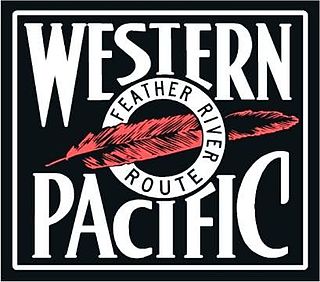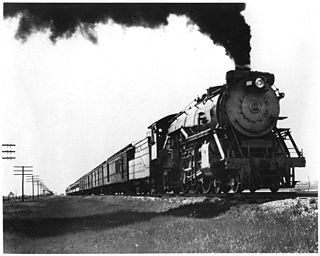
The Denver and Rio Grande Western Railroad, often shortened to Rio Grande, D&RG or D&RGW, formerly the Denver & Rio Grande Railroad, was an American Class I railroad company. The railroad started as a 3 ft narrow-gauge line running south from Denver, Colorado, in 1870. It served mainly as a transcontinental bridge line between Denver and Salt Lake City, Utah. The Rio Grande was also a major origin of coal and mineral traffic.

BNSF Railway is the largest freight railroad in the United States. One of six North American Class I railroads, BNSF has 36,000 employees, 33,400 miles (53,800 km) of track in 28 states, and over 8,000 locomotives. It has three transcontinental routes that provide rail connections between the western and eastern United States. BNSF trains traveled over 169 million miles in 2010, more than any other North American railroad.

The Burlington Northern Railroad was a United States-based railroad company formed from a merger of four major U.S. railroads. Burlington Northern operated between 1970 and 1995.

A tender or coal-car is a special rail vehicle hauled by a steam locomotive containing its fuel and water. Steam locomotives consume large quantities of water compared to the quantity of fuel, so their tenders are necessary to keep them running over long distances. A locomotive that pulls a tender is called a tender locomotive. Locomotives that do not have tenders and carry all their fuel and water on board the locomotive itself are called tank locomotives or tank engines.

The Chicago, Burlington and Quincy Railroad was a railroad that operated in the Midwestern United States. Commonly referred to as the Burlington Route, the Burlington, CB&Q, or as the Q, it operated extensive trackage in the states of Colorado, Illinois, Iowa, Missouri, Nebraska, Wisconsin, Wyoming, and also in Texas through subsidiaries Colorado and Southern Railway, Fort Worth and Denver Railway, and Burlington-Rock Island Railroad. Its primary connections included Chicago, Minneapolis–Saint Paul, St. Louis, Kansas City, and Denver. Because of this extensive trackage in the midwest and mountain states, the railroad used the advertising slogans "Everywhere West", "Way of the Zephyrs", and "The Way West".

The Norfolk and Western Railway, commonly called the N&W, was a US class I railroad, formed by more than 200 railroad mergers between 1838 and 1982. It was headquartered in Roanoke, Virginia, for most of its existence. Its motto was "Precision Transportation"; it had a variety of nicknames, including "King Coal" and "British Railway of America". In 1986, N&W merged with Southern Railway to form today's Norfolk Southern Railway.

The Monongahela Railway was a coal-hauling Class II railroad in Pennsylvania and West Virginia in the United States. It was jointly controlled originally by the Pennsylvania Railroad, New York Central subsidiary Pittsburgh and Lake Erie Railroad, and the Baltimore and Ohio Railroad, with NYC and PRR later succeeded by Penn Central Transportation. The company operated its own line until it was merged into Conrail on May 1, 1993.

The Western Pacific Railroad was a Class I railroad in the United States. It was formed in 1903 as an attempt to break the near-monopoly the Southern Pacific Railroad had on rail service into northern California. WP's Feather River Route directly competed with SP's portion of the Overland Route for rail traffic between Salt Lake City/Ogden, Utah, and Oakland, California, for nearly 80 years. The Western Pacific was one of the original operators of the California Zephyr passenger line.

The St. Louis–San Francisco Railway, commonly known as the "Frisco", was a railroad that operated in the Midwest and South Central United States from 1876 to November 21, 1980. At the end of 1970, it operated 4,547 miles (7,318 km) of road on 6,574 miles (10,580 km) of track, not including subsidiaries Quanah, Acme and Pacific Railway and the Alabama, Tennessee and Northern Railroad; that year, it reported 12,795 million ton-miles of revenue freight and no passengers. In 1980 it was purchased by and absorbed into the Burlington Northern Railroad. Despite its name, it never came close to San Francisco.

The Black Hills Central Railroad is a heritage railroad that operates in Keystone, South Dakota, United States. The railroad was added to the National Register of Historic Places on February 5, 2003.
The Indiana Rail Road is a United States Class II railroad, originally operating over former Illinois Central Railroad trackage from Newton, Illinois, to Indianapolis, Indiana, a distance of 155 miles (249 km). This line, now known as the Indiana Rail Road's Indianapolis Subdivision, comprises most of the former IC/ICG line from Indianapolis to Effingham, Illinois; Illinois Central successor Canadian National Railway retains the portion from Newton to Effingham. INRD also owns a former Milwaukee Road line from Terre Haute, Indiana, to Burns City, Indiana, with trackage rights extending to Chicago, Illinois. INRD no longer serves Louisville, Kentucky, and the Port of Indiana on the Ohio River at Jeffersonville, Indiana, through a haulage agreement with the Louisville & Indiana Railroad (LIRC).

The Fort Worth and Denver Railway, nicknamed "the Denver Road," was a class I American railroad company that operated in the northern part of Texas from 1881 to 1982, and had a profound influence on the early settlement and economic development of the region.

The Colorado and Southern Railway was an American Class I railroad in the western United States that operated independently from 1898 to 1908, then as part of the Chicago, Burlington and Quincy Railroad until it was absorbed into the Burlington Northern Railroad in 1981.

Standard gauge was favored for railway construction in the United States, although a fairly large narrow-gauge system developed in the Rocky Mountains of Colorado and Utah. Isolated narrow-gauge lines were built in many areas to minimize construction costs for industrial transport or resort access, and some of these lines offered common carrier service. Outside Colorado, these isolated lines evolved into regional narrow-gauge systems in Maine, New York, Pennsylvania, Ohio, Iowa, Hawaii, and Alaska.
Crawford Hill is a helper district with an average 1.55% eastbound grade between Crawford, Nebraska, United States, at an elevation of 3,678 feet (1,121 m), and Belmont, Nebraska at 4,499 feet (1,371 m) on the BNSF Railway Butte Subdivision. Crawford Hill climbs the Pine Ridge escarpment—formations of buttes and grassy dense sand hills lined with ponderosa pines. Manned helper engines based in Crawford are used to help 18,000-ton loaded coal trains from Wyoming's Powder River Basin up the escarpment.

The Wabash Railroad was a Class I railroad that operated in the mid-central United States. It served a large area, including track in the states of Ohio, Indiana, Illinois, Iowa, Michigan, and Missouri and the province of Ontario. Its primary connections included Chicago, Illinois; Kansas City, Missouri; Detroit, Michigan; Buffalo, New York; St. Louis, Missouri; and Toledo, Ohio.
The Iowa and St. Louis Railway (I&SL) was a subsidiary United States railroad operating in south-east Iowa and north-east Missouri from 1902 to 1947. For most of its existence it was part of the Chicago, Burlington and Quincy Railroad (CBQ), familiarly known as the Burlington System.

Chicago, Burlington and Quincy 4963 is a preserved class "O-1a" 2-8-2 "Mikado" type steam locomotive originally built by the Baldwin Locomotive Works in 1923 for the Chicago, Burlington and Quincy Railroad. It was used by the CB&Q to haul mainline freight trains before it was leased to the Bevier and Southern Railroad to haul short-distance freight trains in the early 1960s. It was subsequently retained by the CB&Q and used as a source of spare parts before being acquired by Richard Jensen.















